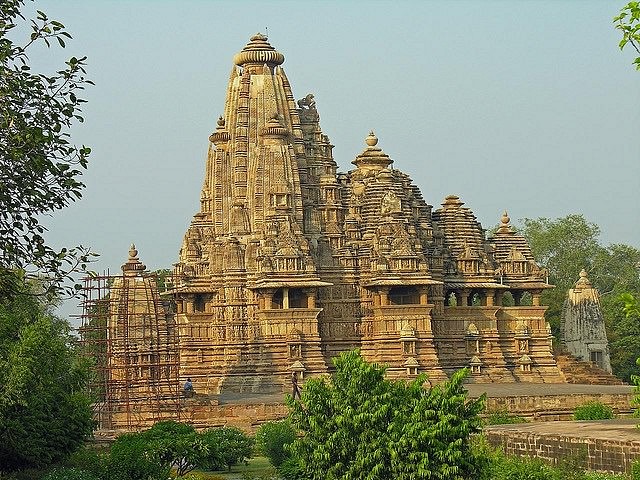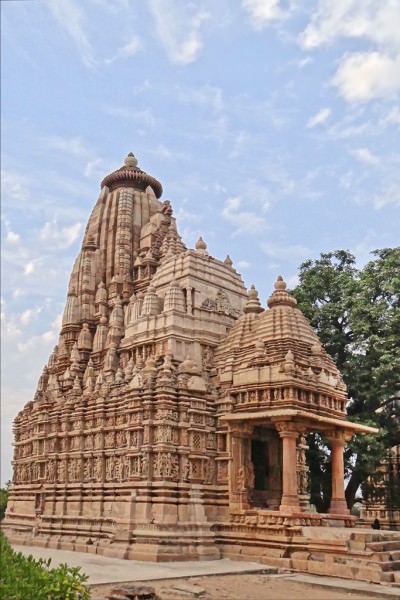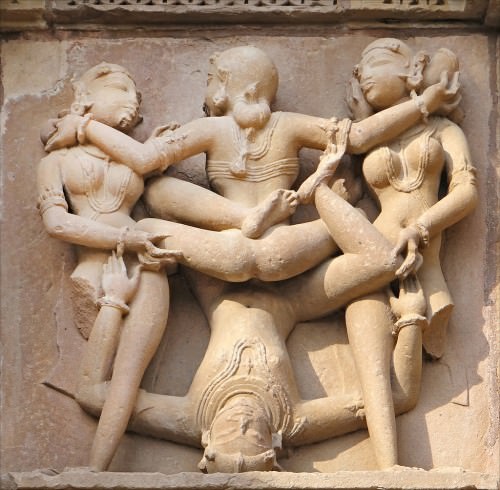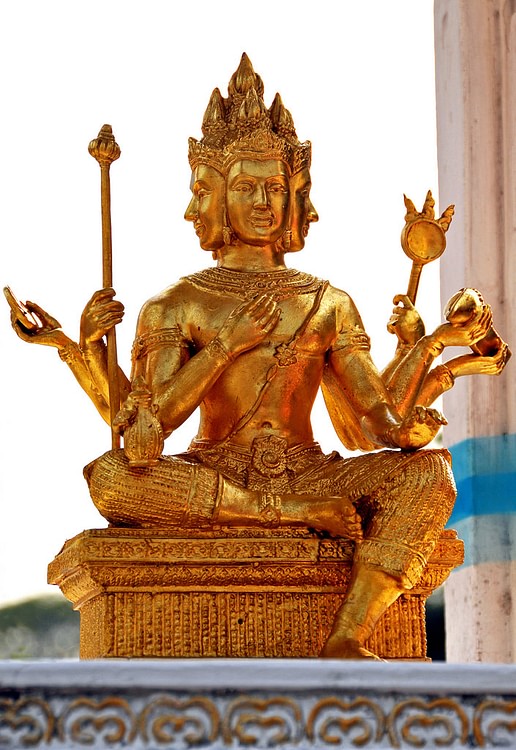Khajuraho › Brahma » Ancient origins
Articles and Definitions › Contents
- Khajuraho › Antique Origins
- Brahma › Who Was
Ancient civilizations › Historical and archaeological sites
Khajuraho › Antique Origins
Definition and Origins

Khajuraho was an ancient city in the Madhya Pradesh region of northern India. From the 10th to 12th century CE it was the capital of the Chandella kings who ruled Bundelkhand. Despite Khajuraho's once great reputation as an important cultural centre there are no surviving non-religious buildings, but the presence of 35 Hindu and Jain temples make it one of the most significant historical sites in India today and worthy of its name given by the 11th century CE Muslim historian Abu Rihan Alberuni as 'the City of the Gods'.
ARCHITECTURAL HIGHLIGHTS
Most of the temples at Khajuraho were built using sandstone but four also used granite in their construction. In the latter group is the Chaunsat Yogini (64 tantric goddesses), built c. 875-900 CE, which has 64 shrine rooms arranged around a rectangular courtyard. Next in the site's development came the Lalguan Mahadeva, Brahma, and Matangesvara temples which are all quite plain in design and decoration compared to the later temples.
HINDU TEMPLES WERE REPRESENTATIVE OF THE HIMALAYAS AND THE 'WORLD MOUNTAIN'
The majority of temples at Khajuraho were constructed between 950 and 1050 CE and are either Hindu (Saiva or Vaisnava) or Jain. The most famous is the Kandariya Mahadeo built in the early 11th century CE and dedicated to Shiva. The more or less contemporary Laksmana temple was built in 954 CE by King Dhanga (r. 950-999 CE) to celebrate independence from the Gurjara-Pratihara rulers and has a similar layout and exterior to the Kandariya Mahadeo. So too does the Visvanatha temple (c. 1002 CE) which was designed by Sutradhara Chhichchha. Both temples have shrines at each corner of their terrace platforms. The Laksmana was dedicated to Vishnu and its terrace is of particular note as it carries a narrative frieze running around all four sides: Elephants, warriors, hunters, and musicians form a procession watched by a ruler and his female attendants.
Other notable temples at the site include the single-towered Caturbhuja and Vamana, the squat Matulunga, and the rectangular, more austere Parshvanatha Jain temple with its unique shrine added to the rear of the building (c. 950-970 CE).Probably the latest temple at Khajuraho is the Duladeo which was built on a star-plan.

Parsvanatha Temple, Khajuraho
THE KANDARIYA MAHADEO TEMPLE
The Kandariya Mahadeo temple is perhaps the most eye-catching building at Khajuraho and it is certainly the largest. Built around 1025 CE during the reign of Vidyadhara (r. 1004-1035 CE), the temple is an excellent example of the fully-developed North Indian temple design. The exterior has a spectacular series of towers ( sikharas ) which progressively reach higher from the entrance to the tallest sikhara (31 metres) above the temple's sacred shrine ( garbhagriha ) at the rear. The main sikhara is also surrounded by quarter and half- sikharas and is topped with a large amalaka - a ribbed circular stone. Thus the building appears like a mountain range of diverse peaks, a deliberate intention by the architect as Hindu temples were representative of the Himalayas and the 'world mountain', an effect which would have only been accentuated by its original white gesso coating, now lost.
Oriented to the east and laid out in a double-cross plan, the temple is built on a high platform base which is accessed by a flight of steps leading to a series of porches. The main porch, or mandapa, has interior polygonal columns with sculpted figure brackets which support a corbelled dome. The whole carries gavakshas – double curved arches. The interior garbhagriha is semi-circular and flanked by passages which lead to exterior balconies with stone awnings.

Mithuna Figures, Khajuraho
The Kandariya Mahadeo temple is richly decorated with sculpture; 646 figures on the exterior and 226 inside the building. The majority of figures are a little under one metre tall and arranged in two or three tiers. They are predominantly figures of Shiva and other Hindu deities such as Vishnu, Brahma, Ganesha, along with attendants, surasundaris (celestial maidens), and mithuna (lover) figures.
The erotic sculptures, which include scenes of bestiality, especially those on the south wall of the antarala, are carved in high relief with the figures depicted in all manner of acrobatic poses. Their purpose is to represent fertility and happiness, further, they are also considered auspicious and protective, an important function precisely at the architectural weak point of the building between the garbhagriha and mandapa.
MAP
Brahma › Who Was
Definition and Origins

Brahma is the Hindu Creator god. He is also known as the Grandfather and as a later equivalent of Prajapati, the primeval first god. In early Hindu sources such as the Mahabharata, Brahma is supreme in the triad of great Hindu gods which includes Shiva and Vishnu.
Brahma, due to his elevated status, is less involved in picturesque myths where gods take on human form and character, but is rather a generally abstract or metaphysical ideal of a great god. In later Puranas (Hindu epics) Brahma is no longer worshipped and other gods are assigned his myths, even if he always maintains his status as the Creator god. Brahma's epithet is ekahamsa, the One Swan. His vahanam ('vehicle') is a peacock, swan or goose. He is still honoured today with an annual ceremony at the pilgrimage site of Pushkar in Rajasthan, India and he remains a popular figure in South-east Asia, especially in Thailand and Bali.
BRAHMA THE CREATOR
In the beginning, Brahma sprang from the cosmic golden egg and he then created good & evil and light & dark from his own person. He also created the four types: gods, demons, ancestors, and men (the first being Manu). Brahma then made all living creatures upon the earth (although in some myths Brahma's son Daksa is responsible for this). In the process of creating, perhaps in a moment of distraction, the demons were born from Brahma's thigh and so he abandoned his own body which then became Night. After Brahma created good gods he abandoned his body once again, which then became Day, hence demons gain the ascendancy at night and gods, the forces of goodness, rule the day. Brahma then created ancestors and men, each time again abandoning his body so that they became Dusk and Dawn respectively. This process of creation repeats itself in every aeon. Brahma then appointed Shiva to rule over humanity although in later myths Brahma becomes a servant of Shiva.
BRAHMA CREATED THE FOUR TYPES: GODS, DEMONS, ANCESTORS, AND MEN.
Brahma had several wives, the most important being his daughter Sarasvati who, after the Creation, bore Brahma the four Vedas (Holy books of Hinduism ), all branches of knowledge, the 36 Raginis and 6 Ragas of music, ideas such as Memory and Victory, yogas, religious acts, speech, Sanskrit, and the various units of measurement and time. Besides Daksa, Brahma had other notable sons including the Seven Sages (of whom Daksa was one), and the four famous Prajapatis (deities): Kardama, Pancasikha, Vodhu, and Narada, the latter being the messenger between gods and men.
BRAHMA CREATES WOMEN & DEATH
In the myths told in the Mahabharata, Brahma created women, the source of evil amongst men:
A wanton woman is a blazing fire...she is the sharp edge of the razor; she is poison, a serpent, and death all in one.
The gods feared that men could become so powerful that they might challenge their reign, therefore, they asked Brahma how best to prevent this. His response was to create wanton women who 'lusting for sensual pleasures, began to stir men up. Then the lord of gods, the lord, created anger as the assistant of desire, and all creatures, falling into the power of desire and anger, began to be attached to women.' ( Mahabharata in Hindu Myths, 36).
In another myth Brahma's first female is also Death, the evil force which brings balance to the universe and which ensures there is no over-crowding of it. The figure of Death is picturesquely described in the Mahabharata as 'a dark woman, wearing red garments, with red eyes and red palms and soles, adorned with divine ear-rings and ornaments' and she is given the job of 'destroying all creatures, imbeciles and scholars' without exception ( Mahabharata in Hindu Myths, 40). Death wept and begged Brahma to be released from this terrible task but Brahma remained unmoved and sent her on her way to perform her duty. At first Death continued her protests by performing various extraordinary acts of asceticism such as standing in water in complete silence for 8,000 years and standing on one toe on the top of the Himalaya mountains for 8,000 million years but Brahma would not be swayed. So Death, still sobbing, performed her duties bringing endless night to all things when their time came and her tears fell to the earth and became diseases. Thus, through Death's work, the distinction between mortals and gods was preserved forever.

Brahma
BRAHMA IN ART
Brahma is often represented in red with four heads, symbolic of his creation of the four Vedas. Thus he is often called Caturanana/Caturmukha or 'four-faced' and Astakarna or 'eight-eared'. Originally Brahma had five heads but when he lusted after his daughter Sandhya an outraged Shiva cut off the head which had ogled the goddess (or burned it with his central eye).Brahma is also represented with four arms. One right hand holds the brahma-tandram, an oval disk with a beaded rim which is perhaps a sacrificial ladle and used to mark men's foreheads with their destiny. The other right hand holds a rosary made from rudraksham seeds. One left hand holds a cleansing vase and he sometimes holds his bow Parivita or the Vedas.Brahma may also be depicted sitting on the sacred lotus flower which sprang from Vishnu's navel, a scene especially common in Cham art.
In Cambodian art, Brahma -known as Prah Prohm - is again represented with four heads and often riding a sacred goose, the hamsa (a popular form of depiction in Javanese art, too), and so the god may in this guise be referred to as Hansavahana. In Tibet, where Brahma is known as Tshangs-pa or White Brahma ( Tshangs-pa dkar-po ), he often rides a horse and carries a white bull and a sword.
LICENSE:
Article based on information obtained from these sources:with permission from the Website Ancient History Encyclopedia
Content is available under License Creative Commons: Attribution-NonCommercial-ShareAlike 3.0 Unported. CC-BY-NC-SA License